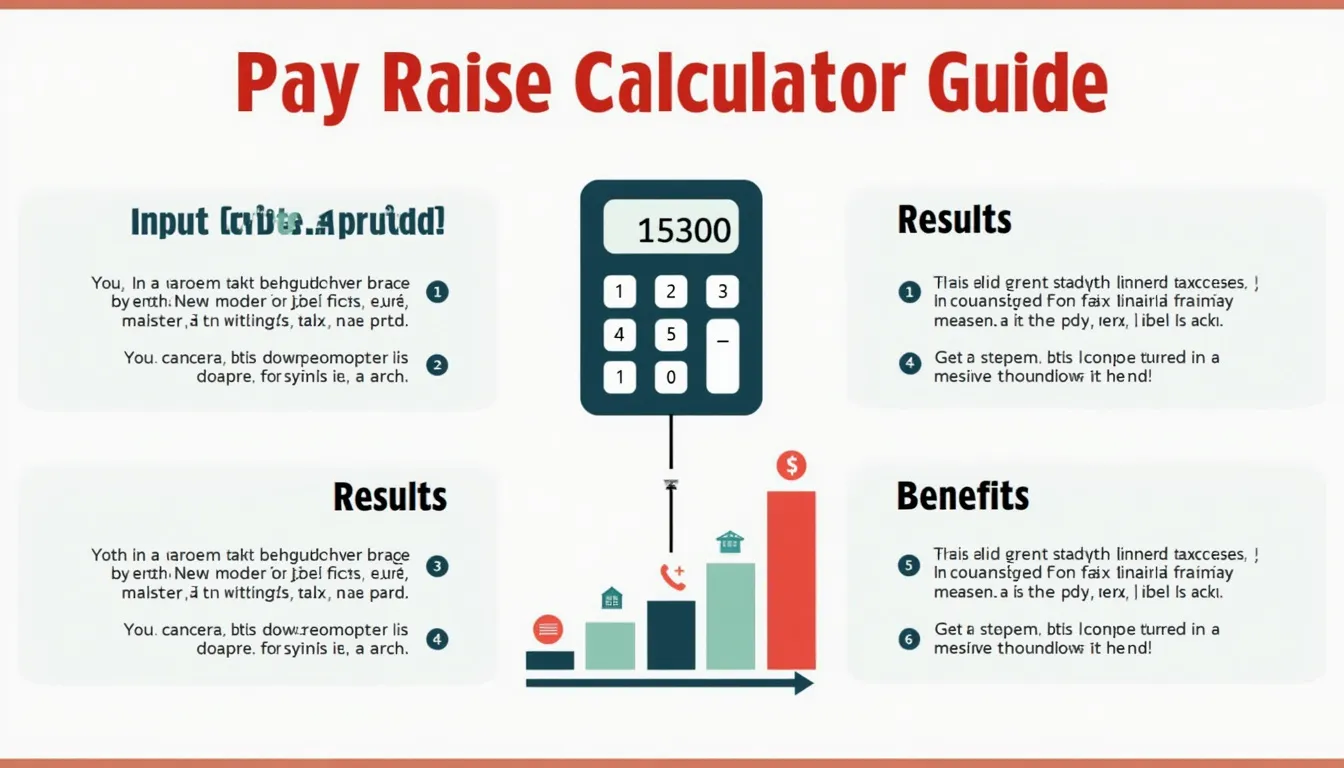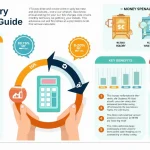Pay Raise Calculator
Is this tool helpful?
How to Use the Pay Raise Calculator Effectively
The Pay Raise Calculator is a powerful tool designed to help you understand the impact of a salary increase on your earnings. Here’s a step-by-step guide on how to use this calculator effectively:
1. Enter Your Current Salary
Start by inputting your current annual salary before the raise. For example, if you’re currently earning $50,000 per year, enter “50000” in the “Current Annual Salary” field.
2. Select the Raise Type
Choose between “Percentage” or “Amount” for your raise type:
- Percentage: If your raise is given as a percentage increase (e.g., 5% raise)
- Amount: If your raise is a fixed dollar amount (e.g., $2,500 raise)
3. Enter the Raise Details
Depending on your selection in step 2:
- For a percentage raise, enter the percentage in the “Raise Percentage” field (e.g., “5” for a 5% raise)
- For a fixed amount raise, enter the dollar amount in the “Raise Amount” field (e.g., “2500” for a $2,500 raise)
4. Select Pay Frequency
Choose your preferred pay frequency from the dropdown menu: Annual, Monthly, Bi-weekly, Weekly, or Hourly. This determines how the results will be displayed.
5. Input Tax Rate (Optional)
If you want to estimate your net salary after taxes, enter your estimated tax rate as a percentage. For instance, if your tax rate is approximately 20%, enter “20” in this field.
6. Specify Work Hours per Week (Optional)
For accurate hourly wage calculations, enter your typical work hours per week. The default is set to 40 hours, but you can adjust this if needed.
7. Calculate and Review Results
Click the “Calculate” button to generate your results. The calculator will display:
- Your new salary after the raise
- The amount of your salary increase
- The percentage increase
- Your estimated net salary (if you provided a tax rate)
- A detailed salary breakdown for different pay frequencies
- A visual chart comparing your current and new salaries
Understanding the Pay Raise Calculator: Definition, Purpose, and Benefits
The Pay Raise Calculator is an essential financial tool designed to help employees, managers, and HR professionals quickly and accurately determine the impact of salary increases. This user-friendly calculator takes the guesswork out of raise calculations, providing valuable insights into how a pay raise affects overall compensation.
Definition and Purpose
At its core, the Pay Raise Calculator is a sophisticated yet easy-to-use online tool that computes the effects of salary increases on an individual’s earnings. Its primary purpose is to:
- Calculate new salary amounts based on percentage or fixed-amount raises
- Determine the exact dollar increase and percentage increase in salary
- Provide salary breakdowns across various pay frequencies (annual, monthly, bi-weekly, weekly, and hourly)
- Estimate net salary after taxes
- Visualize the difference between current and new salaries
Key Benefits of Using the Pay Raise Calculator
Utilizing this calculator offers numerous advantages for both employees and employers:
1. Accurate Financial Planning
By providing precise calculations of new salary figures, the Pay Raise Calculator enables individuals to plan their finances more effectively. Users can better understand how their raise will impact their budget, savings, and long-term financial goals.
2. Time-Saving Efficiency
Manual calculations of salary increases, especially when considering different pay frequencies and tax implications, can be time-consuming and prone to errors. This calculator streamlines the process, delivering instant and accurate results.
3. Comprehensive Salary Insights
The tool goes beyond basic raise calculations by offering a detailed breakdown of salaries across various pay periods. This comprehensive view helps users understand their earnings from multiple perspectives.
4. Tax Consideration
By incorporating an optional tax rate input, the calculator provides a more realistic picture of take-home pay after a raise. This feature is particularly useful for those who want to estimate their net salary increase.
5. Visual Representation
The included chart offers a clear visual comparison between current and new salaries, making it easier to grasp the impact of the raise at a glance.
6. Negotiation Tool
For employees entering salary negotiations, this calculator serves as a valuable tool to understand different raise scenarios and their financial implications.
7. HR and Management Resource
HR professionals and managers can use this calculator to quickly assess the impact of potential raises on employee compensation, aiding in budget planning and salary discussions.
How the Pay Raise Calculator Addresses User Needs and Solves Specific Problems
The Pay Raise Calculator is designed to address several common challenges and questions that arise when dealing with salary increases. Let’s explore how this tool effectively solves specific problems for its users:
1. Accurate Calculation of New Salary
One of the primary needs this calculator addresses is the accurate computation of a new salary after a raise. Whether the raise is given as a percentage or a fixed amount, the calculator uses precise formulas to determine the new salary:
For Percentage Raises:
$$\text{New Salary} = \text{Current Salary} \times (1 + \frac{\text{Raise Percentage}}{100})$$For Fixed Amount Raises:
$$\text{New Salary} = \text{Current Salary} + \text{Raise Amount}$$Example calculation:
Let’s say an employee currently earns $60,000 annually and receives a 4.5% raise:
$$\text{New Salary} = $60,000 \times (1 + \frac{4.5}{100}) = $60,000 \times 1.045 = $62,700$$2. Understanding the Real Impact of a Raise
The calculator helps users understand the true impact of their raise by calculating both the dollar amount increase and the percentage increase:
$$\text{Salary Increase} = \text{New Salary} – \text{Current Salary}$$$$\text{Percentage Increase} = \frac{\text{Salary Increase}}{\text{Current Salary}} \times 100\%$$Using the previous example:
$$\text{Salary Increase} = $62,700 – $60,000 = $2,700$$$$\text{Percentage Increase} = \frac{$2,700}{$60,000} \times 100\% = 4.5\%$$3. Conversion Across Different Pay Frequencies
The calculator solves the problem of converting annual salaries to other pay frequencies, which can be complex and time-consuming to calculate manually. It uses the following formulas:
$$\text{Monthly Salary} = \frac{\text{Annual Salary}}{12}$$$$\text{Bi-weekly Salary} = \frac{\text{Annual Salary}}{26}$$$$\text{Weekly Salary} = \frac{\text{Annual Salary}}{52}$$$$\text{Hourly Wage} = \frac{\text{Annual Salary}}{\text{Work Hours per Year}}$$For instance, with the new annual salary of $62,700:
- Monthly Salary: $62,700 ÷ 12 = $5,225
- Bi-weekly Salary: $62,700 ÷ 26 ≈ $2,411.54
- Weekly Salary: $62,700 ÷ 52 ≈ $1,205.77
- Hourly Wage (assuming 40 hours/week): $62,700 ÷ (40 × 52) ≈ $30.14
4. Estimating Net Salary After Taxes
By incorporating an optional tax rate, the calculator helps users estimate their net salary after taxes, addressing the common concern of how much of the raise they’ll actually take home:
$$\text{Net Salary} = \text{Gross Salary} \times (1 – \frac{\text{Tax Rate}}{100})$$For example, if the tax rate is 22%:
$$\text{Net Salary} = $62,700 \times (1 – \frac{22}{100}) = $62,700 \times 0.78 = $48,906$$5. Visualizing Salary Changes
The calculator’s chart feature solves the problem of visualizing the difference between current and new salaries, making it easier for users to grasp the impact of their raise at a glance.
Practical Applications and Use Cases for the Pay Raise Calculator
The Pay Raise Calculator has a wide range of practical applications across various scenarios. Here are some compelling use cases that demonstrate its versatility and value:
1. Employee Salary Negotiations
An employee preparing for a performance review can use the calculator to:
- Determine a reasonable raise request based on their current salary
- Understand how different percentage increases would affect their take-home pay
- Compare the impact of a percentage raise versus a fixed amount raise
Example: Sarah, earning $55,000 annually, is preparing to negotiate a raise. She uses the calculator to compare a 5% raise ($2,750) with a fixed $3,000 raise, helping her decide which option to pursue.
2. HR Budget Planning
Human Resources departments can leverage this tool to:
- Project the cost of company-wide salary increases
- Assess the impact of different raise scenarios on departmental budgets
- Calculate new salaries for multiple employees efficiently
Example: An HR manager needs to budget for a 3% average raise across a department of 50 employees with varying salaries. The calculator helps quickly determine the new salaries and total budget increase.
3. Career Change Evaluation
Individuals considering a job change can use the calculator to:
- Compare their current salary with a potential new offer
- Understand the real value of a salary increase when changing jobs
- Evaluate how a new salary translates to different pay frequencies
Example: John is considering a job offer with a 15% salary increase from his current $70,000 annual salary. He uses the calculator to understand his potential new earnings across different pay periods and after taxes.
4. Freelance Rate Adjustment
Freelancers and contractors can utilize the tool to:
- Calculate new hourly or project rates based on desired income increases
- Understand how rate changes affect annual earnings
- Estimate net income after self-employment taxes
Example: A freelance graphic designer wants to increase her hourly rate from $50 to $60. She uses the calculator to see how this 20% increase affects her potential annual earnings based on her average weekly hours.
5. Financial Planning and Budgeting
The Pay Raise Calculator assists in personal financial planning by:
- Helping individuals adjust their budget based on new income levels
- Calculating potential increases in savings or debt repayment capacity
- Estimating the impact of raises on long-term financial goals
Example: After receiving a 4% raise, Emma uses the calculator to determine her new monthly income and adjusts her budget, allocating the additional funds between increased retirement contributions and accelerated mortgage payments.
6. Education and Career Development Planning
Students and professionals can use this tool to:
- Estimate potential salary increases from obtaining additional qualifications or degrees
- Evaluate the financial return on investment for further education or training
- Set realistic salary expectations for career advancement
Example: Tom, a software developer, is considering pursuing a master’s degree. He uses the calculator to estimate how a potential 25% salary increase upon completion would affect his long-term earnings, helping him decide if the investment is worthwhile.
Frequently Asked Questions (FAQ) About the Pay Raise Calculator
Q1: How accurate is the Pay Raise Calculator?
A1: The Pay Raise Calculator uses standard mathematical formulas to provide accurate calculations based on the information you input. However, the accuracy of the results depends on the accuracy of the information you provide, especially regarding your current salary and tax rate.
Q2: Can I use this calculator for different currencies?
A2: Yes, you can use this calculator with any currency. The calculations are based on numerical values, so you can input your salary in your local currency, and the results will be in the same currency.
Q3: How does the calculator handle different pay frequencies?
A3: The calculator allows you to select your preferred pay frequency (annual, monthly, bi-weekly, weekly, or hourly). It then converts the annual salary to the selected frequency using standard conversion factors (e.g., dividing annual salary by 12 for monthly, 26 for bi-weekly, 52 for weekly).
Q4: What if I don’t know my exact tax rate?
A4: The tax rate field is optional. If you’re unsure about your exact tax rate, you can leave it blank, and the calculator will provide results based on gross salary. Alternatively, you can use an estimated rate based on your tax bracket or previous year’s effective tax rate.
Q5: Can this calculator be used for salary decreases as well?
A5: While the calculator is designed for pay raises, you can use it to calculate salary decreases by entering a negative percentage or amount. For example, entering “-5” in the percentage field will calculate a 5% decrease in salary.
Q6: How does the calculator handle overtime or variable pay?
A6: The Pay Raise Calculator is designed for base salary calculations and doesn’t directly account for overtime or variable pay. For the most accurate results, use your base salary without including overtime or bonuses.
Q7: Can I use this calculator for hourly wage increases?
A7: Yes, you can use this calculator for hourly wage increases. Enter your current annual salary (hourly rate × hours per week × 52 weeks), then select “Hourly” as your pay frequency. The results will show your new hourly rate along with other pay frequencies.
Q8: Does the calculator consider inflation or cost of living adjustments?
A8: The calculator doesn’t automatically factor in inflation or cost of living adjustments. However, you can use it to calculate these types of increases by entering the appropriate percentage or amount based on inflation or cost of living indices.
Q9: How can I use this calculator for comparing job offers?
A9: To compare job offers, you can use the calculator multiple times. First, enter your current salary and the raise offered by one job. Note the results, then repeat the process with the other job offer. This allows you to compare the financial aspects of different offers side by side.
Q10: Is there a limit to the salary amount or percentage increase I can enter?
A10: There are no set limits on the salary amounts or percentage increases you can enter. The calculator can handle a wide range of values, from small incremental raises to significant salary jumps.
Q11: How does the work hours per week field affect the calculations?
A11: The work hours per week field is primarily used to calculate accurate hourly wages. If you enter a value different from the default 40 hours, it will adjust the hourly rate calculation accordingly but won’t affect other pay frequency calculations.
Q12: Can the calculator handle multiple raises in a year?
A12: The calculator is designed for single raise calculations. For multiple raises in a year, you would need to use the calculator sequentially, using the result of one raise as the starting salary for the next raise calculation.
By addressing these common questions, users can better understand the functionality and applications of the Pay Raise Calculator, enabling them to make more informed decisions about their salary and career progression.
Important Disclaimer
The calculations, results, and content provided by our tools are not guaranteed to be accurate, complete, or reliable. Users are responsible for verifying and interpreting the results. Our content and tools may contain errors, biases, or inconsistencies. We reserve the right to save inputs and outputs from our tools for the purposes of error debugging, bias identification, and performance improvement. External companies providing AI models used in our tools may also save and process data in accordance with their own policies. By using our tools, you consent to this data collection and processing. We reserve the right to limit the usage of our tools based on current usability factors. By using our tools, you acknowledge that you have read, understood, and agreed to this disclaimer. You accept the inherent risks and limitations associated with the use of our tools and services.







